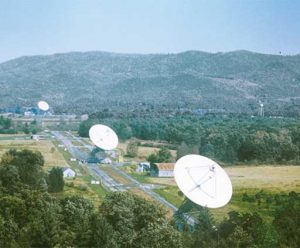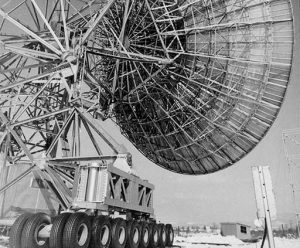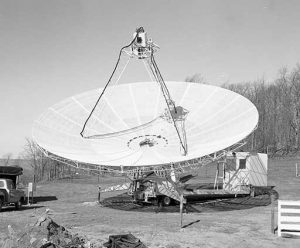
In the 1960s, we wanted to build an array of radio telescopes called an interferometer that simulates a larger telescope from the combined observations of strategically-aligned smaller ones. When the waves of these separated telescopes are combined, the signals get stronger and the noise flattens out, creating sharper views of radio objects.
However, before such a large-scale project could be funded, we needed to prove our design’s hardiness and our ability to operate it.
From 1959 in Green Bank, we had been running a successful and busy 85-foot telescope, called the Tatel Telescope, that we bought as a kit from Blaw-Knox Corporation. Blaw-Knox was still making these kits in 1963 when we ordered another 85-footer from them to create a two-telescope observing system.
By February of 1964, we had assembled this near-twin 85-foot radio telescope that we named the 85-2. The 85-2 differed slightly from the Tatel in that it had 80 14-ply truck tires permanently mounted to its frame. Using a D-7 Caterpillar and an Army surplus aircraft towing tractor, we could haul the 85-2 closer or farther away from the static Tatel to change the pair’s combined resolution and sensitivity.
In anticipation of our new movable arrival, we built a mile and a half-long track leading away from the Tatel. We placed the 85-2 at the end of the new track for maximum distance and mounted six staging stations at 1000-ft intervals along the track. Each station had three piers for stability and sockets for data and power lines that ran the length of the track, some buried, some suspended above on trays.
Cabling between the 85-2 and the 85-foot Tatel took several months, and, with the first digital autocorrelator to combine their observations, the two finally became a working interferometer on June 1, 1964. The interference patterns of the telescopes’ combined radio wave observations told astronomers about position, size, and strength of objects in space.

Renamed the Green Bank Interferometer, this pair’s interference (fringe) patterns were very good, showing astronomers the periodic changes in radio signals from objects that dimmed and brightened over time. Within the first year of GBI observations, the major astronomy report from the National Academy of Sciences recommended the immediate funding and building of a large-scale radio telescope array as a national science facility. We began experiments and discussing designs for what would become that national facility, the Very Large Array in New Mexico.
We built for the GBI a new control room and added a third 85-foot Blaw-Knox telescope to the middle of the interferometer track in spring of 1967, greatly increasing the sensitivity of the Green Bank Interferometer. The 85-3, too, had truck tires mounted on either side, and we used it to test multiple baselines – but still only in one, short direction, running roughly northeast to southwest. For a true test of a high-resolution array, we needed a telescope located far outside of that track.
Therefore, that year, a fourth portable telescope was added to the Green Bank Interferometer. The dish of this portable kit telescope was half the size of the others, 42 feet. This unique telescope could be dismantled and hauled away on the truck that also ran its control desk and motorized mount.
The 42-foot telescope was hauled first to a location 8 miles from its larger siblings. It later was relocated to a site 11 miles north-northeast, a mountaintop called Spencer Ridge. (The distance is the same as an arm of the Y-shaped VLA, still under design at the time.) Finally, it was sited on a ridge in Huntersville, West Virginia, 26 miles from Green Bank, the same distance of the longest baseline of the VLA.
Its observations were wirelessly transmitted as a microwave data link down the mountains to a receiver that sent the signal into the autocorrelator, still in the little building along the GBI track.
By 1972, the aging surface of the 42-foot portable was too inaccurate for our increasing research needs, and the unique telescope package was given to Cornell for interferometer work at its Arecibo observatory in Puerto Rico.
A new, 45-foot portable replaced the outgoing 42-foot in 1973 and served through 1983 on the Huntersville mountaintop. It was brought back to the Green Bank site as a stand-alone telescope, still in use, but now as a solar radio telescope.
A new 46-foot portable dish telescope was placed on Point Mountain to complete the VLA test work. In 1988, with the VLA nearly a decade into its reign as the best interferometer on Earth, the 46-foot was given to the NOAA, moved to Fortaleza, Brazil in 1991, and served as an element in their Earth-mapping VLBI project.
The GBI continued doing important scientific observations into the 21st century.
Discoveries

The Green Bank Interferometer was not solely a VLA testbed. It was a fully-functioning, state-of-the-art interferometer on its own. Most notably, in mid-February of 1974, the GBI discovered an intense and point-like source of radio waves coming from the heart of our Milky Way Galaxy. Named Sagittarius A*, this incredibly compact object was soon determined to be a supermassive black hole. Until 1978, the GBI’s detailed views were used for studying fine structure in known radio objects. The GBI completed the first radio measurement that confirmed, to high accuracy, Einstein’s prediction of the bending of light (i.e. any electromagnetic radiation) near a massive body, commonly called Einstein rings or gravitational lensing.
From 1978 to 1996 the GBI was operated by the US Naval Observatory for its studies of Earth rotation (for accurate timekeeping) and monitoring of variable sources, such as pulsars. From 1996 until 2000 the GBI was in continuous use, funded partly by NASA, for studies of X-ray and Gamma-ray sources.
From 1995 until 2000, the GBI carried out a survey focused on the binary star systems Beta Persei and V711 Tauri — both are about 95 light-years from Earth. These stars orbit each other, but are pairs of different types of stars. Beta Persei is the prototype of the “Algol” class of interacting binary stars. An Algol system contains a hot, blue, main sequence star, along with a cool, orange/red star that is more active than our Sun. V711 Tauri is an “RS Canum Venaticorum” binary, which contains two cool stars that behave like our Sun. The continuous monitoring program, the longest ever completed, also demonstrated that Beta Persei and V711 Tauri have short- and long-term cycles, and active and inactive cycles. These data will help us to better understand our Sun’s activity.
The Green Bank Interferometer ceased operations on October 6, 2000, but the newer 85-foot telescopes had contract jobs for some years after, observing pulsars and other transient radio objects. They are still in working order and ready to take on new contract jobs.
85-foot stats
- Reflector: 85-foot diameter paraboloid; Surface is 0.125 inch thick aluminum panels; Surface area is 5700 square feet with better than 0.125 inch RMS tolerance.
- Focus: 36 feet above reflector surface and 115 feet above ground; Carries 600 pounds of receiving equipment; position relative to paraboloid stable to 0.25 inch.
- Mount: Equatorial (polar and declination axis, mutually perpendicular)
- Declination Axis: Shaft is 40 feet long, 16 inches diameter; gear is 40 feet diameter; Travel is 132 degrees total, 48 degrees north of stow and 84 degrees south of stow.
- Polar Axis: Shaft is 23 feet long, 28 inches diameter; Gear is 48 feet diameter; Travel is about 90 degrees either way from stow.
- Drive Rates, Both axes: Slew is 20 degrees per minute; Scan is up to 4 degrees per minute.
- Material: Painted steel superstructure.
- Total Weight: 210 tons.
- Pointing Precision: About 30 arc seconds (about a quarter at 600 feet).
- Baseline: 2400 meters at an azimuth of 62 degrees (E of N).
- Bands: 8.3 GHz (X-band) and 2.25 GHz (S-band) with 35 MHz bandwidth.
- Receivers: Cryogenically cooled, dual frequency, dual polarization. Both X and S bands simultaneously observed in both right and left circular polarizations.
- System temperature: About 35 K in Sband and 45 K in Xband.
- Sensitivity: RMS noise in a 5-minute scan is about 6 mJy in S-band and 10 mJy in X-band for point sources.
- Minimum integration time: 30 seconds.
In the News
There were no posts found.





